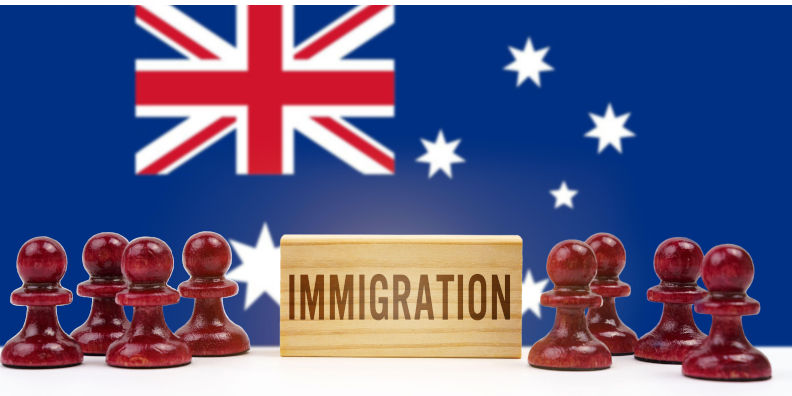When will immigration return to 'normal'?
November 4, 2025
Despite assurances from Immigration Minister Tony Burke that immigration is “ trending back towards historically normal levels”, all indicators suggest it is once again overshooting Treasury’s projection. Indeed, it looks like the descent may have stalled and might rebound.
Net overseas migration (NOM) includes only those arrivals who remain in Australia for 12 of the subsequent 16 months – hence it can be calculated only up to 16 months in arrears, although the ABS releases quarterly estimates with a six-month lag. However, the net permanent and long-term arrivals (NPLA) data, released monthly by the ABS, have long been used as a useful early indicator of NOM trends. While NPLA is often a little higher than NOM and shows more seasonal variation, if NPLA is higher this year than last then, in all likelihood, so is NOM. So far 2025 has broken a record for NPLA, causing ABC staffer Alan Kohler to conclude, “I think we can confidently say that immigration has stopped declining”.
This is happening in the context of nation-wide protests against “mass immigration” and intense commentary from media and government to say, “nothing to see here, except a bunch of dangerous right-wing racists". While there were “good people” in those rallies, they concede, they have been misled by extremists. The very term “mass immigration” is deemed dog-whistling xenophobia.
Shifting the benchmark
According to The Guardian, “those getting angry over migration are suffering from recency bias”, forgetting what happened during COVID: net migration was at a 100-year low and since then we’ve only been playing catch-up. That claim is still made despite cumulative NOM overtaking the pre-pandemic trend by October 2023.
Said the kettle to the pot, have you forgotten the strengthening calls to slow down immigration before COVID? Congestion and unaffordable housing are not exclusively post-pandemic issues. Perhaps the rallies reflect frustration with the spectacular squandering of the opportunity afforded by border closures to reset immigration to a less painful pace.
After 70 years averaging under 90,000 per year, NOM was ramped up sharply from 2005, averaging 227,000 per year between 2006 and 2019. Such a sustained high rate was not only unprecedented for Australia, it was exceptional among developed countries, growing Australia’s population by a whopping 45% since the turn of the century.
Regardless of whether housing and infrastructure kept pace, it did so at the expense of natural habitats and prime farmland, water security, urban amenity, lifestyle choices and increasing state government debt. It constitutes a fierce headwind against our efforts to reduce greenhouse gas emissions.
So, it is little wonder that Australians are unimpressed by the argument that immigration is returning to normal, if “normal” is defined by the pre-pandemic decade.
A mood for change
Before the pandemic, repeated surveys reported a majority of Australian voters wanted lower immigration. Since many people don’t know how much immigration adds to our population, these surveys underestimate the support for moderation: when asked if Australia needs more people, in 2018, 71% said no. The same result was recorded in 2023.
For immigration to return to normal, NOM should be less than 90,000 per year. For it to comply with the majority of Australians’ wish to stop population growth, it should be closer to 70,000. This is the number that would make up for below-replacement birth rates to keep the population stable once the current growth momentum dissipates.
For all Labor’s insistence that the housing crisis is only an issue of supply, it’s a mathematical truth that reducing NOM by 200,000 would improve housing availability by at least 80,000 units, without sacrificing a single tree or heritage building, or crowding a road, hospital or school. State governments would save tens of billions per year in unneeded infrastructure.
However, Burke dismissed any target for NOM, claiming it would hamper Australia’s agility to match immigration to our needs. He infers current intakes are finely tuned to Australia’s needs. Yet only around a quarter of permanent migrants are skilled primary applicants — the rest average well below the general population for workforce participation and income — with all of them demanding skills and adding strain to infrastructure and housing. While Burke boasts of giving out “21,000 visas for healthcare workers [and] 15,524 for construction”, double those numbers would be needed among 300,000 migrants, if not to exacerbate skills shortages.
Jobs and Skills Australia found “more than 50% of international graduates working in Australia are employed well below their skill levels”. Visa fraud is rife. The massive expansion of guest-worker programs has not matched an increase in horticultural production, but has left many workers underemployed and mercilessly exploited. These are not the hallmarks of a well-targeted and regulated immigration program.
Instead of digging in on failed migration settings to defy racists, Australia could take a lesson from Denmark or Canada. By heeding popular calls to lower immigration, they have defused support for right-wing groups while easing rents and unemployment.
However, as with tax reform, environmental law, climate change and transparency, the Albanese Government seems incapable of standing up to vested interests.
The views expressed in this article may or may not reflect those of Pearls and Irritations.
